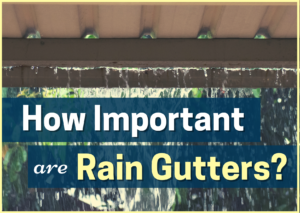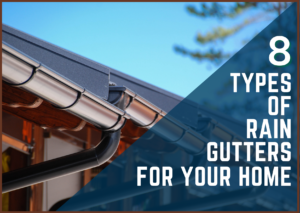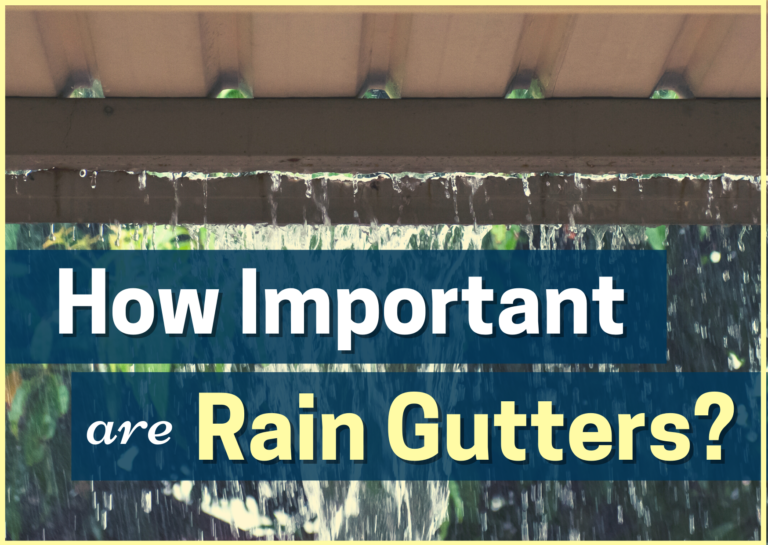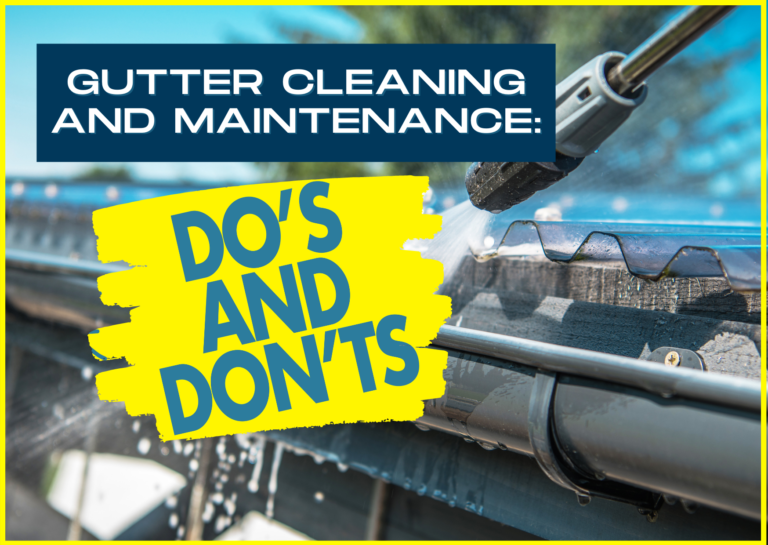Sprucing up your home and yard is never a bad idea! You can tell when a person loves their home, and tracking any home remodeling project could be challenging but fulfilling. No matter how extensive or little the home improvement is, result and outcome seems just equally gratifying. It’s time to pay attention to the other aspects in your home that are highly important but often ignored.
But before you start, let us answer one of the most important home improvement questions: Do you need rain gutters in your home?
Rain gutters play a significant role in most homes, and there are even some properties where it is more valuable than any other home system you can think of. If your roof is washing out your foundation, you can have many issues that come with the water flow. Water is the enemy of your house from top to bottom. Mother Nature is no joke, and can cause havoc on your house in several ways, none of which are cheap or easy to fix. Doing everything correctly from the start is a good way to maintain a home. Water is for sure not a friend to your home!
Understanding Rain Gutters
Before you decide to utilize or forego rain gutters, it is crucial to make more efforts in understanding more about them. Rain gutters’ primary function is to provide an outlet or waterway for rainwater to be redirected elsewhere. This will prevent many dirty and messy occurrences in your home’s exteriors like erosion or flooding. Gutters are responsible for guiding the water effectively towards the drain or a designated area in your home. Although they are quite productive, there are certain limitations for their capacity, so overflow possibilities are still likely to happen, especially if there will be clogs and debris stuck into it. Rain gutters are usually attached to your roofs, and they are made of materials like copper, aluminum, and plastic.
When are Rain Gutters Necessary?
Can you tell if your house needs an effective gutter system? Here are some example instances where you can relate to, and if so, you should contact your professional gutter installers.
1. If your ground is rich in clay.
Some grounds are rich in clay materials, and we sometimes are not aware of this fact. This situation could be challenging to work with since water can dissipate into your foundation, and the clay will serve as the deliverer. Chances are your ground will always be wet with water. Using gutters will help you avoid this situation; it will relate to a drainpipe as well as a ground-based gutter line, and you’re all good. It enables you to channel the water away from your home.
2. If your home’s landscape slopes upwards.
Having your house at the bottom of a slope on either side will lead to having water pooling on your foundation. It could happen for both above or lower ground, and this could be a disaster since it will lead to inconvenience and make your home’s foundation a wet mess. To avoid this, install a gutter on one side, in which it can redirect the water into the downward slope. It is even much better to secure a small channel connected to the ground so that any water slipping from the sides can escape your landscape.
3. If your roof has a little or no overhang.
Some home designs depict the roof being close to the home, and this means that water can pour right into the foot of your foundation. Most homes without gutters are designed in such a manner, and this will create numerous problems. Having frequent rain will lead to forming trenches due to water constantly pouring down and creating indoor puddles. The worst-case scenario happens when water is continuously seeped into the ground, leading to further extensive damage in the future. Another dire circumstance is when you have a waterfall-like downpour from your roof, and it would be hard to pass through your home’s entrance.
How Rain Gutters Can Benefit You
If you happen to live at the top of a hill, that drops off on all sides, where there is no way for water to puddle and run backwards up against your house, you probably are ok not to have gutters in that case. That is really the only way to best describe a house with no need for gutters. The rest of the houses can benefit from gutters.
Now that you realize that your home probably does need a durable rain gutter to find out the numerous benefits it entails. Considering the long-term aspect, you’ll know it was a smart decision.
1. It prevents basement flooding.
If your home’s ground is always soaked with water, the soil becomes exceedingly heavy. Runoff water from your roof will pour into the bottom, creating pressure on the foundation of your home. Due to this occurrence, your basement walls and ground would soon crack. When these tiny cracks happen, water can flow right into these gaps and spaces, and the next thing you know, water will flood right into your basement.
Even with lesser water seeping right into your basement’s cracks, it will still trigger excessive moisture, which then leads to mold growth. When this happens, it could be dangerous to the health of all the people living in your home.
2. It protects the siding of your home.
Without rain gutters, your siding will have unsightly stains caused by the rainwater trenches. Rainwater is not clean as it sometimes carries leaves, dirt, and debris, and these particles can drip down into your sidings, too, creating stain marks. It will leave a bad sight and will decrease your home’s curb appeal.
Having rain gutters will benefit your home’s aesthetics. Additionally, it will retain the quality of your sidings as they remain dry and perfectly conditioned. You don’t have to worry about molds, rots, pests, and insects lurking in with dry sidings.
3. It prevents erosion.
Water pooling down into your foundation will cause massive erosion. If your home has a soil landscape, it will be continuously washed away every time it rains. Your landscape will not only be ruined, but water will continue to overflow and even reach your home, especially during hard rain or storms.
Because of erosion, you can notice your foundation starting to settle. This will also lead to uneven floors and cracked walls over time. Having rain gutters will prevent all this from happening, so you can continue admiring your beautiful landscape and soils.
4. It keep the quality of your garden beds.
Having flowers and shrubs create an adorable aesthetic for your home. If you’re the type who enjoys gardening, then consider installing rain gutters ultimately for this purpose. Rainwater pouring down into your soil could easily drown your garden beds and, of course, lead to erosion.
Puddles of water will drown your plants and ruin all you have invested in your garden. Make sure to have rain gutters so that you can protect the condition of your plants and flowers, even during the rainy and winter season.
Kinds of Rain Gutters for Your Home
Most homeowners always go for full rain gutters, especially if you seriously consider flooding and heavy rain. If you live in a city where there are frequent rain and storm, it’s always smarter to invest in sturdy kinds of rain gutters. Here are the different construction shape types:
1. K-Style Gutters
This is the most widely used style of gutter these days because of its decorative feature. Most people refer to it as “ogee,” and many homeowners love using it because of its curvy profile. It is similar to a crown molding; that’s why many people install it around their ceilings. This design can hold a lot of rainwater, so you don’t need to worry about overflow. It’s sustainable for those residing in rainy areas and cities.
These gutters can be used with different materials and sizes, and you can contact your preferred expert roofers if you want to have them customized for your home. This is highly recommended if you want the product to be seamless and leak-proof.
2. Victorian Ogee
With a unique design and named Old gothic, this kind of gutters provides a decorative outline that suits most homes. This uses cast-iron, as it was prevalent in the past. This has been a traditional option for channels, but its stylish feature is still relatively loved by many residents. Although its size is usually the downside, since it only accumulates a limited amount of water, many people, regardless, select this gutter design for their traditional and period homes.
This is perfect for smaller homes since they are narrow in size. They can also be customized according to your roof’s design.
3. Half-Round Gutters
A half-round type of gutter is perfect for you if your main priority is to add appeal to your home. This gutter design is sleek and sophisticated, combining the look of traditional and architectural gutters. There are different designs of these half-round gutters so that you can select between double-bead, reverse bead, and single-bead.
There is not much difference on each kind of half-round gutter if you tackle its performance. You can specifically choose its material as well. The best thing about it is its possibility to conceal and be hidden. You can opt for concealed hangers, which result in having no visibility on your ceilings.
4. Fascia Gutters
With your homes having an absent fascia board, this style of gutters will suit your taste. Why? Because it will serve two purposes in one product. It can serve as a gutter and your fascia board at the same time. This can also be concealed in your ceiling so no one can visibly see it.
You can enjoy its beautiful and neat design while enjoying the premier advantages of water damage prevention.
5. European Gutters
Last but not least, these gutters are named after their design. It is often attached to homes with half-round hangers. This entails a classy and elegant aura, which is always pleasing to your home’s aesthetics value. Most homeowners choose this option for that reason. You can retain their perfect condition by utilizing shiny and distinctive coating products.
Consider this type of gutter if you live in an area where it’s prone to have temperature changes and extreme weather conditions. The materials and design of these gutters are robust and can hold up despite the challenging external factors that impact them. However, it will not succumb and will not incur any damage. One of this design’s fantastic features is the wide downpipes attached to it, which will never cause any clogs and overflow.
When Can You Forego Rain Gutters?
Some homes and properties could function well even without the support of rain gutters. Having them when you don’t necessarily need them will contribute to more costs, which are unnecessary. Here are some situations where you can omit the idea of installing gutter systems:
1. If your home’s landscape slopes downwards.
Opposite to the previous statement, if your home is built in an area with a downward slope, then you can genuinely ignore the idea of having gutters. These devices could seem obsolete for neighborhoods located in a downhill area. There is no need to use rain gutters because your home’s slope is going downward, allowing water to fall and escape pooling into your home’s foundation.
2. If your geographic location only expects little rainfall every year.
This idea plays a significant role in deciding whether or not to get a rain gutter system. If you live in an arid town or city, it means that rain is very rare, and so, it won’t ever cause any rainwater to pour down your home and create a mess. Having more sunshine than rain means you can save your investment for rain gutters and use it for other home improvement ideas instead. Check out some home improvement programs offered by the US government.
3. If your roof is extended longer and has an overhang.
If your roof is quite long and runs away from your home and it’s far from your foundation, then you don’t have to worry about water pooling right into your entryway or doorsteps. Some houses are equipped with lengthy roofs that go all the way into the forefront of the house. If this is how your home is designed, then you can omit the concept of installing rain gutters.
Common Complaints About Rain Gutters and Their Solutions
Some people who have experienced the challenges of maintaining gutters and downspouts have a fair share of complaints. But these are all solvable. And if you take into consideration the good and bad aspects of it, you’ll still be able to take advantage of its benefits rather than the troubles they cause.
Gutter Clogs
Known as the most prevalent complaint about gutters, clogging is commonplace, especially for those homes with nearby trees, plants, and greens. This recurrence holds for most parts because the wind will continuously bring all the leaves and dirt into your gutters. But this does not mean it’s challenging to solve. You can add gutter covers, which are practically affordable and will save you the trouble of cleaning your gutters all the time.
Gutter covers entail many benefits, such as blocking leaves and preventing animals from living on them. Although small debris could still enter the openings, rain and water can flush them down right into the gutter’s surface.
You can always refer to some DIY helpful guides in cleaning your gutters. But if, in any case, you would instead prefer to hire professional cleaners to de-clog your gutters, you can hire a roofing professional gutter expert to maintain and clean your gutter clogs.
Ice Dams
Contrary to what some people believe, rain gutters do not cause ice dams. However, gutters influence to concentrate ice, particularly at the roof’s edgy area. This occurrence is most likely to happen in many top surfaces of your home and is not limited to your gutter system. Ice dams can create a problem even in your attic, crawl space, or roof. The cause for such happening is due to poor ventilation and insulation. When this happens, contact a professional to sort out the underlying issue and provide long-term solutions







